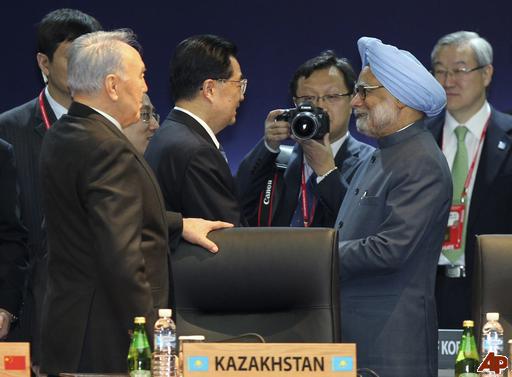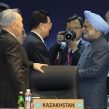
Kazakhstan Adamant to Lead in Global Nuclear Non-Proliferation Efforts
Publication: Eurasia Daily Monitor Volume: 9 Issue: 61
By:

In Soviet times, the Kazakh republic was a testing ground for nuclear explosions, having witnessed more than 400 nuclear blasts at the site in Semipalatinsk. Much has changed since Kazakhstan gained its independence in 1991. It renounced the world’s fourth largest nuclear arsenal and has displayed a persistent record of either creating or spearheading major initiatives aimed at countering nuclear proliferation. Recently, Kazakhstan has also emerged as the world’s largest uranium producer and a leading exporter, making it imperative for the government to match the country’s domestic successes with international responsibilities. In this light, economic, security, geopolitical and marketing considerations, in particular, have been driving Kazakhstan’s activism on the global non-proliferation front, helping it position its initiatives as an asset for international efforts against nuclear proliferation.
Indeed, besides returning more than a thousand nuclear warheads to Russia under the START I Treaty and joining the Nuclear Non-Proliferation Treaty (NPT) in 1994, Kazakhstan also agreed to host, operate and maintain approximately a dozen stations on its territory to help with efforts by other countries to detect signs of nuclear explosions. In 2008, it further hosted a special exercise to upgrade inspection capabilities of the not fully ratified Comprehensive Nuclear Test Ban Treaty that seeks to prohibit all nuclear explosions in all types of environments for any purpose (www.kazpravda.kz, January 4; www.kndc.kz). In 2010, Kazakhstan hosted a conference on countering terrorism financing in the framework of the Global Initiative to Combat Nuclear Terrorism and announced a World Declaration for a Nuclear-Free World initiative. It has also called for a nuclear-free zone in the Middle East and implemented a joint project with the US and the International Atomic Energy Agency (IAEA) on the transfer and storage of large amounts of nuclear fuel (www.ng.by, March 14; www.kazakhstanun.org).
This year, Kazakhstan has become the twenty-fourth member of the G-8 Global Partnership against the Spread of Weapons and Materials of Mass Destruction. Just as other countries, Kazakhstan also looks forward to the Nuclear Security Summit in Seoul on March 26-27, which will look for ways to combat the threat of nuclear terrorism and safeguard nuclear materials and facilities. The stakes are high. In April of last year, Astana proposed hosting the world’s first international nuclear fuel bank and is eager to weigh its prospects at this high-level nuclear summit. The IAEA and donors have already promised $150 million for the project, which Kazakhstan believes could take off by 2013. It is envisioned that Russia would supply enriched uranium to Kazakhstan, which would then be available to countries for purchase at a nominal price. The plan seeks to counter WMD proliferation by convincing countries thinking of or pursuing indigenous nuclear production to access enriched fuel in international markets.
Uranium-rich Kazakhstan is interested in attracting much-needed technological and technical expertise to modernize its domestic economy and upgrade its expanding nuclear industry. It is also looking to expand its operations in global markets, which have not come to a halt despite the Fukushima disaster in Japan and safety concerns about nuclear energy use worldwide. A recent report by Nomura International forecasts a deficit of uranium ore within five years, noting that China, India, Russia and South Korea will drive the global demand growth as nations look to expand the use of various forms of alternative energy. There are 53 nuclear power plants being constructed worldwide, with about 500 more planned by 2030. Kazakhstan’s uranium reserves make up 19 percent of global reserves and are the world’s second largest. In 2009, it became the world’s largest uranium producer, beating Canada and Australia. It is developing 21 uranium deposits, seeking to expand its uranium production to 30,000 metric tons by 2018, and aiming not only to produce domestic nuclear power but also become a major supplier of nuclear fuel and reactors (Azattyq, January 29, 2010; EDM, April 15, 2011).
Kazakhstan favors exports of uranium and other energy products to diverse suppliers, in part to strengthen its positions vis-à-vis its large neighbors – China and Russia. It fears their imperial pasts and potentially imperial futures. But it also welcomes them as partners. China is the world’s second largest economy, with a big appetite for energy resources and deep pockets of cash to pay for them. Russia is the world’s third and fourth largest source and producer of uranium, respectively. Its global uranium enrichment capacity of 45 percent (EDM, April 15, 2011) is a lucrative source of enriched fuel for Kazakhstan’s nuclear industry and the proposed fuel bank.
Kazakhstan is new to the world of independent nation-states and, as a relatively successful emerging regional power in the post-Soviet space, it seeks actively to build a niche for itself. From a global security standpoint, the issues of WMD, nuclear terrorism and proliferation are too hot to miss, especially for a Central Asian country leading the world in the production and export of uranium. These topics resonate heavily with agendas of major global actors, most notably the United States. In 2009, President Obama identified nuclear terrorism as a serious threat to international security and confirmed the need to safeguard nuclear materials as part of his vision of a “world free of nuclear weapons” (www.thenuclearsecuritysummit.org).
However, some are concerned about Kazakhstan’s nuclear-related activism. The country needs more cadres to lead its expanding nuclear industry and maintain security and environmental safeguards. Its location in a relatively insecure region further raises risks of proliferation (www.newsland.ru, October 17, 2009; www.thebulletin.org, April 28, 2008). There are also geopolitical risks due to a rivalry by major powers over access to Kazakh uranium resources, making a delicate pursuit of external balancing strategy a priority for Kazakhstan.
The world’s largest uranium producer and a leading exporter, Kazakhstan concurrently is trying to capitalize on its domestic potential while seeking early on to mitigate any external fall-outs. The motivations of Kazakhstan’s activism in the global nuclear non-proliferation arena thus reflect this uneasy reality.




